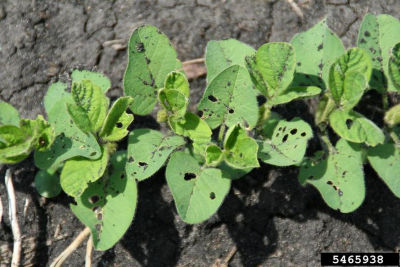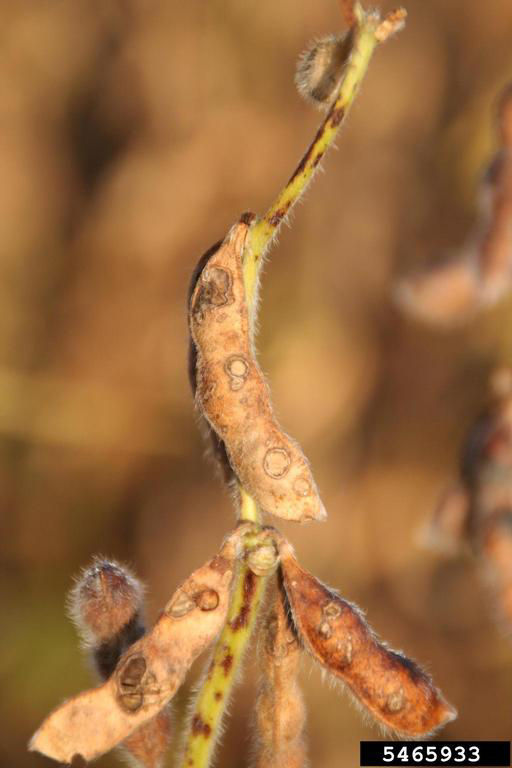4 MIN READ
Watch for Early-Season Bean Leaf Beetles in Soybeans
April 28, 2020
The adult bean leaf beetle is about ¼ inch in length and typically dark yellow; however, coloration can vary from with a wing cover color of yellow, orange, or red, with black markings. Usually there are four black markings on the wing covers, occasionally there may be only two or even they may be absent. However, there is always a triangular black marking on wing covers behind the head (Figure 1). The adults overwinter primarily in leaf debris in woodlots and emerge in the spring and become active once temperatures reach 50 to 55° F. The number of generations per year depends on location; there can be as many as three generations in the southeastern United States, two generations in the central Midwest, and a single generation in Ontario, Canada.1

What crops does the bean leaf beetle attack?
The primary hosts are legumes, but preferred hosts are soybean and green bean. In soybean, injury by the adult results in small, round holes between the major veins on the leaf (Figure 2). The injury differs from the larger, irregular holes caused by caterpillars, such as green cloverworm. While injury can exceed 50% defoliation in the vegetative stages, plants can generally compensate for this leaf loss.3 The first-generation females deposit eggs in the soil of soybean fields and the larvae feed on the roots and nodules. The second generation in the Midwest or third generation in the Southeast emerge later in the summer and feed on the foliage and pods as the leaves mature.

Pod injury can be of two types, pod clipping, and injury to the pod wall. Pod clipping can result in complete loss of the pod as it becomes un-harvestable. Injury to the outer pod wall leads to lesions that may allow moisture and pathogens to enter (Figure 3).

The transmission of viruses (bean pod mottle, cowpea mosaic, and southern bean mosaic viruses) by adult feeding is also possible.
Does the bean pod mottle virus impact the yield or quality of the seed?
Bean pod mottle virus can discolor the seed coat but does not appear to impact seed quality. However, for soybean produced for food grade, bean pod mottle virus can result in a reduction in quality grade because of seed coat staining.1
Do the larvae cause any economic injury?
While the larvae feed on the root tissue and nodules, the injury has not been shown to result in economic injury.2
What is the risk of economic injury by the bean leaf beetle?
While the actual risk of economic injury cannot be determined prior to scouting for the beetle during the growing season, adult survival is dependent on winter temperatures. A study in Iowa found that most beetles are killed within 15 minutes at 14° F.1 Iowa State University Extension developed a prediction map for mortality and it can be found here.
How do I scout for bean leaf beetle adults and what are the treatment guidelines?
If a seed treatment containing an insecticide has not been used, scout soybean seedlings as soon as possible and continue on a weekly basis. Using a treatment guideline from the University of Missouri, if five or more adults are present or one damaged plant per foot of row is found during the vegetative stage, an insecticide application should be considered.3 After canopy closure a sweep net can be used to sweep across the top of the foliage and pods should be examined for feeding injury. If sampling after the seedling stage and prior to the reproductive stages, if 10 or more beetles are collected per foot of row and defoliation is greater than 30% a treatment may be warranted.3 During the reproductive stages prior to seed maturity (R6), treatment is warranted if 10 or more beetles are detected per foot of row and defoliation is greater than 20%. In the later reproductive stages when pod injury can occur, a control tactic should be considered if 15 beetles are collected per foot of row and there is 10% pod damage.3
Sources:
1Bradshaw, J., Rice, M., and Hodgson, E. 2017. Bean leaf beetle. Iowa State University Extension. https://crops.extension.iastate.edu/bean-leaf-beetle
2Bean leaf beetle. 2009. Purdue University Extension. https://extension.entm.purdue.edu/fieldcropsipm/insects/bean-leaf-beetle.php
3Boyd, M., and Bailey, W. 2000. Soybean pest management: Bean leaf beetle. University of Missouri Extension. https://extension2.missouri.edu/g7150
4017_Q2